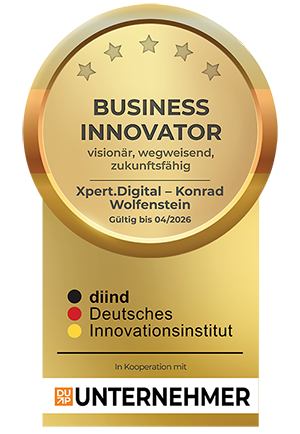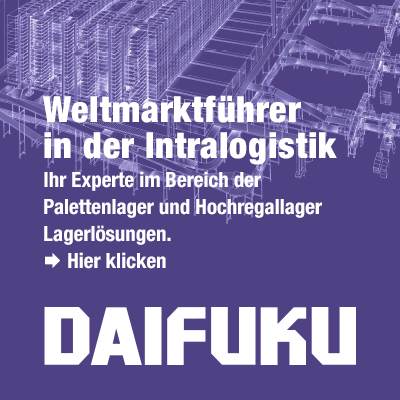Spare parts logistics: Groundbreaking strategies and services for a sustainable industry – digitalization and automation with AI and IoT
Published on: April 23, 2024 / Update from: April 23, 2024 - Author: Konrad Wolfenstein

From Smart to Smarter – Navigating into the future: Spare parts logistics redefined through digitalization and automation – Image: Xpert.Digital
📈🔍 Uncover optimization potential: challenges and opportunities in spare parts logistics
🔧 Spare parts logistics: Groundbreaking strategies and services for a sustainable industry
In a world characterized by rapid technological change and rising customer expectations, spare parts logistics plays a key role. Companies are faced with the challenge of making their spare parts supply chains not only more efficient and cost-effective, but also more resilient and customer-centric. Innovative concepts and strategies as well as the use of new technologies are required.
The importance of optimized spare parts logistics can hardly be overestimated, as it has a direct impact on customer satisfaction, brand loyalty and ultimately business success. Delays in the supply of spare parts lead to downtimes, which can lead to expensive production losses, particularly in industries such as automotive, aviation or mechanical engineering. Therefore, managers from supply chain management, logistics and business development are actively looking for ways to revolutionize their spare parts logistics.
🚀 Technological innovations as a driving force
Digital technologies are at the forefront of transforming spare parts logistics. Blockchain technology, for example, enables transparent and forgery-proof documentation of supply chains. This increases confidence and efficiency when sourcing spare parts. The use of artificial intelligence (AI) and machine learning makes it possible to better predict supply chain risks and take proactive measures. This includes predicting spare parts requirements as well as optimizing inventory levels.
In addition, the introduction of the Internet of Things (IoT) is revolutionizing the way companies manage their spare parts logistics. By connecting devices, companies can be informed in real time about the status of their machines and plan maintenance in advance before failures occur. This concept, known as predictive maintenance, has the potential to dramatically improve spare parts availability while reducing costs.
📈 Strategies for sustainable spare parts logistics
A successful spare parts logistics strategy is based on the digitalization and automation of processes, the flexibility of supply chains and close collaboration with partners. Key strategies include:
1. Digitalization and automation
Implementing ERP (Enterprise Resource Planning) and WMS (Warehouse Management System) systems improves the transparency and efficiency of warehouse and logistics processes. Automation allows companies to respond more quickly to requests and deliver replacement parts in a timely manner.
2. Flexible supply chains
An agile supply chain that is able to quickly adapt to changing market conditions is an essential part of modern spare parts logistics. This includes building safety stocks, using alternative delivery routes and investing in multimodal transport solutions.
3. Collaboration
Collaboration with suppliers, logistics service providers and customers is essential for efficient spare parts logistics. Common platforms and digital marketplaces can facilitate data exchange and increase transparency.
4. Sustainability
In times of climate change, sustainability is also becoming the focus of spare parts logistics. This includes optimizing transport routes to reduce CO2 emissions, using environmentally friendly packaging materials and promoting the circular economy through recycling and reusing spare parts.
⚖️ Challenges and opportunities
Despite the promising possibilities, companies face challenges when implementing sustainable spare parts logistics. These include the complexity of supply chains, the shortage of skilled workers and the need to invest in digital infrastructure. In addition, new technologies and business models require continuous adaptation and willingness to learn from organizations and employees.
However, the integration of advanced analytics, predictive maintenance and 3D printing into spare parts logistics also offers significant opportunities. These technologies enable companies to respond to customer needs more quickly and cost-effectively, develop new business models and differentiate themselves from competitors. By optimizing parts logistics, companies can not only increase their operational efficiency, but also provide exceptional customer service and ultimately expand their market share.
In conclusion, spare parts logistics plays a crucial role in the success of many industries. In a rapidly changing world, it is essential for companies to implement innovative strategies and technologies to optimize their logistics chains and remain competitive. Digital transformation offers enormous opportunities to make spare parts logistics more efficient, sustainable and customer-oriented. Companies that accept this challenge and invest in the future of their spare parts logistics will be successful in the long term.
📣 Similar topics
- 🚀 Innovative approaches to optimizing spare parts logistics
- 🌐 The influence of digital technologies on the supply of spare parts
- ⏱️ Strategies for contemporary and efficient spare parts logistics
- 🤝 The importance of collaboration in modern spare parts logistics
- 🌱 Sustainability: A new dimension in spare parts logistics
- 👁️ Transparency and trust through blockchain in spare parts supply
- 📈 The role of artificial intelligence in predicting spare parts requirements
- 🛠️ Challenges and solutions for sustainable spare parts logistics
- 🔄 From predictive maintenance to 3D printing: technology as a driver of spare parts logistics
- 💡 Digital marketplaces and platforms: the future of spare parts procurement
#️⃣ Hashtags: #Sparepartslogistics #DigitalTransformation #Sustainability #ArtificialIntelligence #PredictiveMaintenance
🔧 Spare parts 2.0: The change through technology in spare parts supply
🔄 From Smart to Smarter: Spare parts logistics redefined through digitalization and automation
In a world where technology plays a central role in almost all areas of life, it is essential that industry also continually takes steps to modernize its processes. One of the most important fields in which innovative technologies are triggering a revolution is spare parts logistics. Increasing digitalization and automation in this sector are opening up unimagined possibilities and fundamentally redefining the way companies manage their spare parts supply. This transformation, which goes far beyond the simple use of intelligent software, requires a profound realignment of traditional processes and ways of thinking.
🚧 The challenges of traditional spare parts logistics
Traditionally, spare parts logistics is confronted with numerous challenges. Long delivery times, inaccurate inventory levels and inefficient distribution are just some of the problems faced by companies worldwide. Additionally, a lack of transparency and inadequate communication often lead to errors and delays that not only impact customer satisfaction but can also result in significant financial losses.
💡 The role of digitalization
Digitalization offers an efficient solution to many of these challenges. By implementing advanced technologies such as the Internet of Things (IoT), artificial intelligence (AI) and big data analytics, companies can monitor their inventory levels in real time, thereby avoiding supply shortages. Furthermore, digitalized inventory management enables a more precise forecast of future demand. This not only leads to an optimization of warehousing, but also to a significant reduction in operating costs.
🤖 Automation as an enabler
Automation goes hand in hand with digitalization and is another key to redesigning spare parts logistics. Robot-controlled systems can, for example, take over the picking and packaging of spare parts, which not only speeds up the processes but also significantly reduces the error rate. In addition, automation through the use of drones or autonomous vehicles enables innovative delivery methods that revolutionize the delivery of spare parts.
🔄 Interoperability for a seamless flow of information
A critical aspect in digitalized and automated spare parts logistics is the interoperability of different systems and technologies. Seamless integration and communication between suppliers, dealers and customers is essential to ensure an efficient flow of information. Standardized data formats and interfaces enable everyone involved to work together smoothly and help to further optimize processes and shorten delivery times.
🌱 Sustainability through digitalization and automation
In addition to economic advantages, the transformation of spare parts logistics through digitalization and automation also makes a significant contribution to sustainability. Through improved forecasting of demand and the associated optimization of inventory levels, overproduction and waste can be reduced. At the same time, intelligent route planning and the use of alternative delivery methods enable a reduction in CO2 emissions.
🔮 The future of spare parts logistics
The path to fully digitalized and automated spare parts logistics is undoubtedly associated with challenges. Nevertheless, developments in this area show that the advantages far outweigh the disadvantages. Companies that recognize the opportunities of this transformation early on and invest in appropriate technologies will not only increase their operational efficiency, but will also be able to sustainably secure their market position.
In the future, more advanced AI systems and machine learning models could optimize parts logistics in unprecedented ways, not only predicting demand more accurately but also adapting and optimizing the entire supply chain in real time. The potential for fully autonomous parts logistics is enormous and could fundamentally change the way we think about supply chains and customer service today.
The digital transformation in spare parts logistics is an ongoing process. The rapid development of technology and the growing demands of the market are constantly driving the industry forward. Companies must be ready to face these challenges by adopting innovative technologies and developing new business models. Redefining spare parts logistics ultimately means rethinking the entire business - from the way spare parts are produced and stored to their delivery and end customer service.
The advanced digitalization and automation of spare parts logistics marks the beginning of a new era. An era in which smart technologies not only make processes more efficient and cost-effective, but also help shape a more sustainable and customer-centric future. With every step we take towards this visionary future, it becomes clear that the concept of “smart” was just the beginning - the goal is an overall system that is not just smart, but smarter in every way.
📣 Similar topics
- 🚀 From traditional to revolutionary: The new era of spare parts logistics
- 💡 Digitalization in practice: Transformation of spare parts logistics
- 🤖 Automation meets spare parts logistics: A look into the future
- 🌍 Spare parts logistics 2.0: How digitalization contributes to sustainability
- 🔍 The invisible hand: AI and IoT in the service of spare parts logistics
- 🌐 Interoperability: The key to efficient supply chains
- 🔄 Redesigning supply chains: challenges and opportunities
- 📊 From data to actions: Big data in spare parts logistics
- 🛠 Smarter processes through advanced technologies
- 🌿 On the way to more sustainable spare parts logistics
#️⃣ Hashtags: #Digitalization#Automation #Sparepartslogistics #Sustainability #TechnologyInnovation

Xpert.Plus warehouse optimization - high-bay warehouses such as pallet warehouses consulting and planning
🚀 The revolution in spare parts logistics: A new future shaped by AI and IoT
➡️ The spare parts logistics landscape is at the beginning of an unprecedented transformation, driven by advancing digitalization and the integration of innovative technologies. Artificial intelligence (AI) and the Internet of Things (IoT) play a central role here and usher in a new era in which efficiency, speed and customer focus are the focus.
The importance of spare parts logistics can hardly be overestimated, especially in an age in which industrial and technological systems are becoming increasingly complex. Efficient and effective supply of spare parts is critical to maintaining operational continuity in many industries, from manufacturing to critical infrastructure. But traditional spare parts logistics models are increasingly reaching their limits, plagued by inefficiencies, high costs and the inability to keep pace with the growing complexity and dynamics of the global market.
Here, AI and IoT open up completely new dimensions: They enable a fundamental redesign of the processes and strategies in spare parts logistics, towards a system that not only acts reactively, but above all proactively and predictively.
🧭 Navigating into a future of digital spare parts logistics
The integration of AI technologies allows in-depth analysis and processing of large amounts of data in real time. This makes it possible to make predictions about the need for spare parts before a failure even occurs. Predictive maintenance, the preventative maintenance based on prediction algorithms, is becoming a reality. Not only does it reduce downtime, it also enables more efficient use of resources and reduces excess inventory in warehouses.
The IoT, with connected devices and sensors, provides the necessary data for these predictions. By continuously monitoring the condition of machines and systems, signs of wear and potential defects can be identified at an early stage. This predictive approach is revolutionizing the way inventory is managed and parts needs are forecast.
🌟 From Smart to Smarter: Infused spare parts logistics
With the introduction of AI and IoT, spare parts logistics will not only become more efficient, but also more intelligent. Automated warehousing systems can independently make inventory optimization decisions by analyzing purchasing patterns, reducing delivery times and improving the availability of spare parts worldwide.
In addition, these technologies enable better traceability of spare parts. By using RFID tags or similar IoT solutions, companies can know exactly where a specific part is at any given time. This not only improves logistics processes, but also increases security and reduces the risk of loss or theft.
💡 Spare parts logistics 2.0: Strategies for a digitalized future
However, implementing AI and IoT technologies requires more than just technological upgrades. It requires a redesign of business models and processes as well as a culture that promotes innovation and continuous learning. Companies need to invest in the skills of their employees to ensure they can fully exploit the potential of these new tools.
Another crucial aspect is security. With increasing networking and data collection, the vulnerability to cyberattacks also increases. It is therefore imperative to implement robust security protocols to protect data and systems.
🌐 The new era of spare parts supply: Services and strategies in the age of AI and IoT
The digital transformation of spare parts logistics not only offers the opportunity to optimize processes, but also to develop new business models and services. For example, the combination of real-time data analysis and prediction enables a transition from standardized to personalized service offerings. Companies can offer customized maintenance plans tailored to their customers' individual needs and operating conditions.
In addition, the use of AI and IoT opens the door to innovative approaches such as “spare parts as a service” models. Here, customers no longer pay for the physical spare part, but rather to ensure its availability. This shifts the focus from pure product delivery to providing a comprehensive, value-based service.
🔄 Sustainable spare parts logistics: An industry in transition
The integration of AI and IoT into spare parts logistics is no longer a distant dream of the future, but is already in full swing. While the transition presents challenges, the benefits – increased efficiency, reduced costs, improved customer satisfaction and the creation of new business opportunities – are undeniable.
With the right focus on innovation, safety and continuous improvement, companies have the opportunity to be at the forefront of this movement and lead spare parts logistics into a new era. The revolution in spare parts logistics is not just a question of technology, but also one of vision, strategy and change. Only those willing to take the plunge and explore the new possibilities will be able to reap the rewards of this exciting future.
📣 Similar topics
- 🤖 The future of spare parts logistics through AI and IoT
- 🌐 The digital transformation of spare parts supply
- ⏱️ Acceleration of spare parts logistics in modern industry
- 🔍 Predictive Maintenance: Revolution through Artificial Intelligence
- 💡 From traditional to innovative: The change in spare parts procurement
- 🔄 Spare parts supply 2.0: Strategies for the digital era
- 🔌 IoT: The backbone of modern spare parts logistics
- 💼 New business models in spare parts logistics through AI and IoT
- 🛠️ Personalized service offerings through real-time data analysis
- 🛡️ Cybersecurity in networked spare parts logistics
#️⃣ Hashtags: #Sparepartslogistics #AIandIoT #DigitalTransformation #PredictiveMaintenance #Cybersecurity
We are there for you - advice - planning - implementation - project management
☑️ Smart City & Factory: Industry expert for energetic 5G buildings and halls as well as advice and installation of solar systems
☑️ Xpert.Plus - logistics consulting and logistics optimization
☑️ Industry expert, here with his own Xpert.Digital Industry Hub with over 2,500 specialist articles
I would be happy to serve as your personal advisor.
You can contact me by filling out the contact form below or simply call me on +49 89 89 674 804 (Munich) .
I'm looking forward to our joint project.
Xpert.Digital - Konrad Wolfenstein
Xpert.Digital is a hub for industry with a focus on digitalization, mechanical engineering, logistics/intralogistics and photovoltaics.
With our 360° business development solution, we support well-known companies from new business to after sales.
Market intelligence, smarketing, marketing automation, content development, PR, mail campaigns, personalized social media and lead nurturing are part of our digital tools.
You can find out more at: www.xpert.digital - www.xpert.solar - www.xpert.plus


























